Fiber Connector Types: SC Vs LC And LC Vs MTP
The rapid pace of information technology has catapulted optical fiber connectors to the forefront, serving as pivotal elements in crafting efficient, high-capacity communication networks. These connectors, evolving in tandem with fiber optic transmission technology, find themselves at the heart of a revolution. The surge in demand for robust communication and data services has not only heightened interest in high-performance fiber optic connections but has also complicated the decision-making process.
Catalog
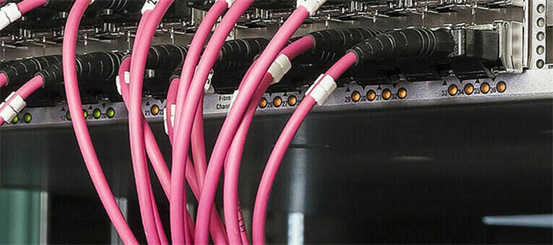
Figure 1: Optical Fiber Connectors
Selecting the correct connector from the many fiber optic connector types such as SC, LC, MTRJ, ST, MTP and FDDI depends on understanding their unique applications and technical nuances. Each one is designed for a specific scenario and has unique features.
Consider the SC Connector (Subscriber Connector): Predominantly seen in data communications and telecom networks, its square design and push-pull mechanism simplify operation. In contrast, the LC Connector (Lucent Connector) thrives in the confined spaces of data centers, thanks to its miniature size and convenient buckle mechanism. The MTRJ connector (Mechanical Transfer Registered Jack) aligns with multimode fiber usage, especially in compact equipment, marked by its dual-fiber, rectangular miniature design.
The ST connector (Straight Tip) finds its niche in multimode systems like LAN and building wiring, featuring a cylindrical, screw-in design. The MTP connector (Multi-fiber Termination Push-on) excels in high-density, high-speed data center applications, supporting multiple fiber channels for fast, voluminous data transfers. Meanwhile, the FDDI connector (Fiber Distributed Data Interface), an elder in the lineup, historically catered to high-speed data in networks and data centers, though it's less favored now.
Diving into market trends and user preferences, we draw comparisons between SC and LC connectors, as well as LC and MTP connectors, to guide users to the most fitting choice. SC fiber connector, with their ease of operation, traditionally suit telecom networks. LC connectors, however, shine in space-limited, high-density environments like modern data centers. When pitting LC against MTP connectors, both serve high-density data environments well, but MTP connectors lead in handling massive data flows with their multi-fiber channel support.
The forthcoming sections delve deeper, offering comprehensive analyses to aid users in navigating the myriad of options and pinpointing the fiber optic connector that aligns seamlessly with their specific needs.
Fiber optic network connectors, pivotal in modern communications technology, transmit data through light pulses, a stark contrast to conventional electrical signaling. This method, with its rapid data transmission speeds and minimal signal loss, becomes a cornerstone in constructing high-speed networks. The crux of fiber optic connectors lies in the precise alignment of minuscule glass fibers, a departure from the reliance on metal pin contacts seen in traditional connectors.
Within the market's diverse range, fiber optic connectors typically comprise three essential parts. The ferrule, the connector's heart, is usually crafted from ceramic, metal, or high-quality plastic. Its role? To precisely position and safeguard the optical fibers, ensuring smooth signal transmission. The connector body, often made from robust plastic or metal, provides support and stability to the ferrule. Then there's the coupling mechanism, a vital component ensuring the connector's firm attachment to devices like network switches or fiber optic couplers. Its design is a direct influencer of the connector's usability and the optical network's overall stability.
In realms demanding high bandwidth and long-distance transmission—think data centers, broadcast systems, urban network infrastructures—fiber optic connectors are indispensable. Their reliability and high performance are instrumental. In the following content, we will detail the different fiber connector types.
What is SC? SC connectors, celebrated for their cost-effectiveness and straightforward installation, have carved a niche in optical fiber communication networks. They are particularly prevalent in point-to-point transmissions and passive optical networks (PON). The design ethos of SC connectors centers around simplicity and practicality, employing a push-pull mechanism that eases installation and reduces maintenance hurdles. This design ensures rapid deployment and operational ease. Their high-quality ceramic ferrules guarantee precise alignment, crucial for environments with stringent return loss demands.

Figure 2: SC Connector
Technically, SC connectors boast low insertion loss (typically <0.3 dB) and high return loss (>50 dB), suitable for both single-mode and multi-mode fibers. Their standard size features a 2.5mm ferrule, which, while effective, can be a drawback in high-density setups.
In comparison with LC and ST connectors, SC connectors edge out with their ease of installation and cost-effectiveness, despite their larger size. In high-density networks, the smaller LC connectors or tailored layout solutions might be employed to mitigate the size constraints of SC connectors.
Practical applications demonstrate SC connectors' efficacy in large data centers and urban fiber networks. Challenges in high-density environments are not insurmountable; with thoughtful design and alternatives, they can be adeptly navigated.
As multi-fiber and miniaturized connection technologies evolve, SC connectors might encounter new competitors. Nevertheless, given their exemplary performance and cost-efficiency, SC connectors are poised to remain a viable, enduring choice in fiber optic communications.
The LC connector, a brainchild of Lucent Technologies from the early 2000s, emerged as a response to the limitations of ST and SC connectors, particularly in size and stability. Its 1.25mm micro ferrule and compact footprint mark a significant leap, especially in high-density realms like data centers and telecom switching centers. The LC's design ethos champions space efficiency and connection stability, providing indispensable flexibility in cramped installation spaces. This makes it a preferred choice in data centers and telecom facilities. Its locking mechanism, both efficient and robust, is a linchpin for stable and reliable signal transmission—vital in the fast-paced world of data communications and high-density chip applications.
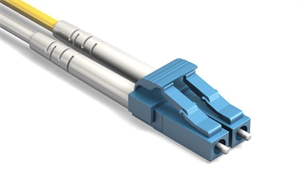
Figure 3: LC Connector
Technically, LC connectors excel with low insertion loss (<0.2 dB) and high return loss (>55 dB), accommodating both single-mode and multi-mode optical fibers. They particularly shine in data transmission ranging from 1 Gbit/s to 10 Gbit/s in High-Speed Ethernet and fiber-to-the-desktop applications.
While LC connectors are the go-to for high-density configurations, they may lag slightly behind SC connectors in terms of physical robustness. However, in practical applications—be it Fiber Channel implementations or urban broadband networks within data centers—LC connectors have proven their mettle, offering efficient data transmission solutions.
As we pivot to the increasing demands for higher density and faster data transfer rates, the significance of LC connectors only escalates. Their design not only meets modern communication needs for space efficiency and rapid data transmission but also lays groundwork for future technological strides.
The evolution of multi-fiber connectors and smaller fiber optic technologies suggests that LC connectors will continue to adapt and overcome new challenges. Currently, in the high-density environments of data centers and telecommunications switching centers, LC connectors stand as pivotal tools for optimizing space and boosting transmission efficiency, underscoring their vital role in optical fiber communications.
In optical fiber communication applications, both SC and LC connectors have demonstrated their unique value and broad applicability. Functioning across various scenarios—LANs, WANs, data centers, telecom switching offices—they share similarities in performance, particularly in maximum insertion loss. Adhering to the TIA/EIA 568B.3 standard, they ensure that the maximum insertion loss in single-mode and multi-mode fiber links remains within 0.75 dB, a critical factor for maintaining optical network stability and signal quality.
SC (Square Connector) and LC (Lucent Connector) connectors, while sharing the same field, diverge in design, performance, application, and cost. A comparative analysis follows:
Design and dimensions:
SC Fiber Connector: Featuring a rectangular "push-pull" design, SC connectors are larger, fitting the bill for past large fiber networks.
LC Connector: Termed as a "mini SC," the newer, smaller LC connector also employs a "push-pull" mechanism, preferred in space-limited environments.
Performance and reliability:
SC Fiber Connector: Reliable due to their size and robust design, SC connectors meet general network requirements for mating cycles and durability.
LC Connector: Small yet mighty, LCs offer superior performance, particularly in high-density networks, and align with high durability standards.
Application areas:
SC Fiber Connector: Common in telecommunications and analog video transmission, SC connectors are staples in older network equipment and some data centers.
LC Connector: LCs excel in high-density applications like modern data centers and enterprise networks.
Cost:
SC Connectors: More affordable, especially in bulk, due to mature technology.
LC Connector: Initially costlier than SCs, but the price gap narrows as technology spreads and production scales up.
Installation and maintenance:
SC Fiber Connector: Easier to handle manually, SCs are straightforward in installation and maintenance.
LC Connector: The LC's miniaturized design may demand more finesse in certain installation and maintenance scenarios.
Compatibility and Standards:
SC Fiber Connector: SCs are integral to many legacy network devices and standards.
LC Connectors: LCs align more with modern standards, notably in FTTH and high-speed data transmission.
The choice between SC and LC connectors boils down to specific application needs. LC connectors are preferable for high-density, modern networking demands, whereas SC connectors fit cost-sensitive or existing SC infrastructure environments. As technology advances, LC connectors are expected to increasingly outpace SC connectors in future network designs.
Small form factor (SFF) connectors, crafted to transcend the spatial constraints of traditional fiber optic connectors, are a leap forward in enhancing connection density. Their compact architecture renders them supremely suited for data centers and dense network environments. When it comes to designing SFF connectors, the mantra is simple yet challenging: shrink in size, soar in performance.
Despite their reduced size compared to standard fiber optic connectors, SFF connectors maintain, if not surpass, signal integrity. They are engineered for faster data transfers, paired with lower insertion and removal forces—a crucial combination for smooth network maintenance and upgrades. As data centers evolve, with servers and storage devices shrinking and space demands intensifying, the relevance of SFF connectors grows exponentially.
From a performance standpoint, these connectors are versatile, supporting both single-mode and multi-mode fibers. This versatility extends to compatibility, with SFF connectors being highly adaptable to various network equipment and fiber optic cable interfaces.
In real-world scenarios, SFF connectors are more than just space savers. They cut costs, enhance network flexibility, and augment scalability, reducing the physical space needed. These features position SFF connectors as vital elements in constructing dense, high-performance network architectures.
MTRJ (Mechanical Transfer Registered Jack) connectors stand out within the SFF category. Developed in alignment with NTT (Nippon Telegraph and Telephone Corporation) standards, they draw inspiration from the RJ (Registered Jack) modular plug. What sets MTRJ apart is its dual-fiber structure, making it particularly adept at duplex data transmission.
Size and density are where MTRJ connectors truly shine. They are especially beneficial in environments like data centers or enterprise networks, where fiber optic connections are numerous but space is at a premium. The MTRJ's design enables high-precision alignment, translating to lower loss and enhanced signal integrity in data transmission.
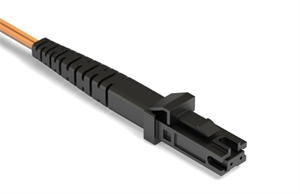
Figure 4: MTRJ Connector
MTRJ connectors are staples in fiber-to-the-desktop (FTTD) solutions within local area networks (LAN) and data centers. They are indispensable for high-bandwidth and reliable network connections. Their standardized design ensures compatibility with diverse network equipment and optical cable systems, offering flexible network layout options.
The user-friendly modular design of MTRJ connectors simplifies installation and maintenance. They can be quickly connected and disconnected, effectively reducing the time and cost associated with network deployment and maintenance.
With their unique dual-fiber structure, precise alignment capabilities, and modular design, MTRJ connectors have cemented their status as essential tools for efficient and stable data transmission in modern modular network environments.
The ST connector, known formally as the Straight Tip connector, stands as a testament to the classics in the realm of fiber optic network applications. Developed by the telecommunications giant AT&T, it quickly garnered popularity in the nascent stages of fiber optic networks, owing to its exceptional reliability and robustness. The design of the ST connector is characterized by a 2.5mm diameter circular ferrule, coupled with a distinctive bayonet-style retention mechanism. This ingenious design ensures a secure attachment to devices upon installation, effectively minimizing loss and interference at the junction, and thus, guaranteeing stable signal transmission.
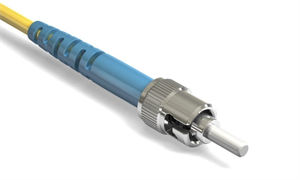
Figure 5: ST Connector
At its core, the ST connector exhibits an inherent adaptability with a range of fiber types, encompassing both single-mode and multi-mode fibers. Such versatility positions the ST connector as a preferred choice across diverse network settings, particularly where frequent connections and disconnections are the norm. Further, its standardized form factor facilitates seamless integration with various fiber optic patch panels and adapters, enhancing its overall flexibility.
However, the march of time has seen the ST connector gradually supplanted by smaller, high-density alternatives, primarily due to its larger size and lower port density. Yet, in certain domains – like industrial and military applications – the ST connector's prominence endures. Here, the robustness and stability of the connection trump concerns over size and density.
The enduring relevance of ST connectors in maintaining and upgrading legacy network systems is undeniable. Despite the shift towards more compact and efficient connectors in modern network infrastructures, ST connectors retain their significance in certain arenas, thanks to their historical importance and distinct benefits.
Transitioning to the realm of multi-fiber connections, the MTP (Multi-fiber Termination Push-on) connector emerges as a sophisticated evolution of the Multi-fiber Push-On (MPO) connector technology. Developed by Conec, the MTP connector showcases exemplary efficiency in multi-fiber connectivity. A standout feature of the MTP connector is its capacity to terminate up to 12 fibers in a single ferrule, with select models extending this capability to 24 or even more fibers. This high-density attribute renders the MTP connector exceedingly suitable for network environments that handle vast volumes of data transmission, such as the backbone, cross-connect, and branch applications in data centers.
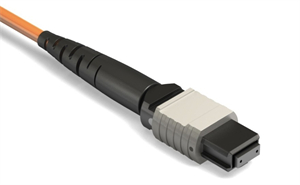
Figure 6: MTP Connector
Designed with installation simplicity and high-precision alignment in mind, the MTP connector is equipped with a precision docking mechanism. This mechanism plays a crucial role in ensuring accurate fiber alignment, thereby substantially reducing both insertion and reflection losses. The modular design of the MTP connector facilitates rapid and versatile deployment in intricate network layouts, typified by high-density fiber optic cabling environments in data centers.
Performance-wise, MTP connectors accommodate various optical fiber modes, including both single-mode and multi-mode fibers. They are apt for a wide array of optical fiber network architectures, with their high compatibility allowing seamless interfacing with diverse fiber optic cabling systems and network equipment. These characteristics – notably the high density and superior performance – position MTP connectors as the go-to choice for constructing contemporary data centers and high-speed network infrastructures.
At the level of market application, MTP connectors find widespread usage in network environments with stringent requirements for bandwidth, density, and rapid deployment. They demonstrate exceptional suitability in the construction of 5G networks, cloud computing infrastructure, and large-scale data processing centers, underscoring their critical role in the evolving landscape of network technology.
The FDDI (Fiber Distributed Data Interface) connector, a paragon of high-performance in the realm of optical fiber interfaces, is intricately designed for the distributed data interface of optical fibers. This connector, more complex in its construction, primarily caters to the demands of FDDI networks—a standard pivotal in high-speed data transmission, especially within the confines of local area networks (LANs). A distinguishing aspect of the FDDI connector is its incorporation of two 2.5mm ferrules. This dual ferrule design not only enhances the connector's stability but also bolsters its reliability, particularly crucial in the rapid currents of high-speed data transmission.
Designed with an eye towards lofty data transfer rates and unwavering network reliability, FDDI connectors find their stronghold in traditional LAN standards, such as Ethernet and Token Ring. These connectors are particularly favored in network architectures thirsting for high bandwidth and minimal latency. Their compatibility with both single-mode and multi-mode fibers lends them a versatility well-suited for diverse network environments.
In practical scenarios, the FDDI connector's large and intricate build gifts it with extra mechanical strength— a trait of considerable importance in various industrial and corporate settings. This strength is central to their prowess in ensuring connection stability and reducing signal loss, thus fostering efficient network performance.
Despite the relentless march of network technology birthing a plethora of new connectors, which have gradually nudged the FDDI connector out of some applications, it remains an irreplaceable component in specific network architectures and legacy systems. The FDDI connector continues to play a critical role in the stable operation and maintenance of these older network systems, underscoring its enduring significance in the ever-evolving landscape of network technology.
In the evolving landscape of market popularity and user concern, LC and MTP connectors have emerged as particularly significant. Their rise to prominence is rooted in their unique suitability for the complex demands of high-density and high-speed data center environments. Each type, LC and MTP, caters to distinct network environments and applications. A comparative analysis is essential for designers and engineers. It aids in selecting the most fitting connector type, tailored to specific network requirements and application scenarios.
Let's delve into the specifics:
LC Connector:
Miniature, yet powerful in high-density applications.
Boasts a 2.5mm ceramic (zircon typically) ferrule, ensuring precision and stability.
The RJ-45 plug feature simplifies installation.
Versatile. Accommodates both single-mode and multi-mode fiber through its double-sided interface.
MTP Connector:
A multi-fiber powerhouse, connecting 12 or 24 fibers simultaneously.
Precision in alignment comes from high-precision guide pins.
Equipped with a user-friendly push-pull plug.
Its realm? High-speed data transmission and high-density networks.
LC Connector:
Excels in lower insertion loss (≤0.3dB) and return loss.
Highly flexible, serving both single-mode and multi-mode applications.
Proven stability in long-distance and high-speed transmission.
MTP Connector:
Battles slightly higher insertion loss due to connecting more fibers. However, its design mitigates this.
A champion for data centers and high-density networks.
Supports enviable higher data transfer rates.
LC Connector:
The go-to for traditional network connections: FTTH, LAN, telecommunications.
Shines in scenarios requiring a single optical fiber connection.
MTP Connector:
The backbone of data centers and extensive network infrastructures.
Thrives in 40G/100G/400G high-speed network environments.
LC Connector:
Economical per optical fiber. Maintenance and troubleshooting? Straightforward.
Replacement and repair don't break the bank.
MTP Connector:
Higher initial investment, but a long-term efficiency booster.
Maintenance and troubleshooting demand specialized tools and expertise.
LC Connector:
A staple in current networks, with a bright future ahead.
Compatible and easily integrates with existing systems.
MTP Connector:
In step with the growth of data centers and high-density networks.
Ready for the future's high-speed data transmission trends.
In conclusion, the choice between LC and MTP connectors hinges on application specifics, network environment, and budgetary considerations. LC connectors fit like a glove in traditional networks and cost-sensitive applications. MTP connectors, on the other hand, are the heroes of modern, high-density, high-speed data centers and expansive network infrastructures.
The modern communication network's intricate tapestry owes much to the nuanced world of optical fiber connectors. A journey that starts from the classic SC and LC connectors and progresses to the high-efficiency wonders of MTP and MTRJ, each type of connector announces its unique set of strengths and ideal usage scenarios. Choosing the right fiber optic connector is an art; it hinges on a deep, nuanced comprehension of their technical traits and the specific contexts where they shine. This understanding is critical for striking a balance between high density, rapid transmission, and cost-effectiveness.
Zooming in, we see each connector as a master in its own right, carving out distinctive roles within the network infrastructure. SC connectors, hailed for their simplicity and dependability, stand in stark contrast to the high-density expertise of MTP connectors. LC connectors, celebrated for their compact design, find their niche in space-constrained environments. MTRJ connectors, meanwhile, marry efficiency with economy, showcasing the ingenuity of their design.
As technology's pace quickens and network demands burgeon, the horizon is lined with the promise of even more innovative fiber optic connectors. These future innovations, foreseen as paragons of efficiency and adaptability, are set to be instrumental in shaping next-generation communication networks. It's this anticipation, intertwined with a sustained focus and comprehension of evolving technologies, that sets a solid groundwork for the networks of the future.
In sum, the story of optical fiber connectors is more than a chronicle of technological progression; it's a narrative of adapting to the fluctuating demands of communication networks. From their modest origins to their anticipated advanced future, these connectors are both the chroniclers and builders of network history, heralding a future where communication is swifter, denser, and more efficient.
Frequently Asked Questions [FAQ]
1. What is the difference between green and blue SC connectors?
The SC connector, a staple in fiber optic communications, appears in various hues, each signaling a distinct purpose.
Green SC Connector: Often seen in APC (Angled Physical Contact) terminations, this connector stands out with its slanted end face, angled approximately 8 degrees. This unique design is key in mitigating return loss and elevating signal quality, a necessity for high-bandwidth, long-distance communications.
Blue SC Connector: In contrast, the UPC (Ultra Physical Contact) termination is where the Blue SC Connector shines. Its flat end face is optimized for general fiber optic communication. Ubiquitous in fiber optic networks, it's a familiar sight in data centers and local area networks.
2. What are the types of fiber optic connectors?
A plethora of fiber optic connectors exist, each boasting unique applications and distinct characteristics. The variety is extensive. The SC Connector, notable for its square interface, operates with a push-pull plug-in mechanism. In contrast, the ST connector, with its circular interface, relies on a rotating bayonet mechanism. Smaller yet similar to the SC is the LC connector. Then there's the FC connector, a spiral bayonet type, predominantly employed in single-mode optical fiber contexts. For those dealing with multi-mode fiber, the small dual-fiber MT-RJ connector is common. Lastly, the MPO/MTP connector, catering to high-density fiber optic communications, stands out for managing multiple fibers.
3. How do fibre connectors work?
The intricate working principle of fiber optic connectors hinges on high-precision optical alignment technology. Its sole aim? To align two optical fibers' end faces with pinpoint accuracy, thus ensuring efficient optical signal transmission. Let's delve into the crucial steps and considerations involved:
Prepare Fiber:
Stripping: Begin with professional tools to meticulously peel off the protective coating, revealing the optical fiber within. Precision is paramount here; even microscopic damage to the fiber core could be detrimental.
Cutting: Then, employing fiber cutting tools like high-precision fiber cutters, trim the fiber. The cut's angle and flatness are not mere details; they're pivotal, impacting signal transmission efficiency.
Polishing: Finally, using special discs and fluid, polish the fiber end face to perfection. Flatness and cleanliness? Non-negotiable. They're critical in reducing light loss at the point of connection.
Alignment:
This step leverages advanced technology (think movable V-grooves and fine-tuning mechanisms) to align the fiber ends at a microscopic level. Why? Because precision alignment is the linchpin in minimizing signal loss and reflections.
Physical Connection:
Here, choose the right fiber optic connectors (SC, LC, ST, and others) based on your needs—single-mode, multi-mode, different network environments. Within these connectors, a ceramic or metal sleeve plays a crucial role. It's all about stabilizing and safeguarding the fiber end face, maintaining alignment under physical contact.
Signal Transmission:
Now, with the fibers precisely aligned and securely connected, signal transmission becomes a showcase of efficiency. Optical signals zip through the aligned core, relying on total internal reflection and signal propagation. What's the result? Swift, reliable data communication.
In these connectors, considerations like the signal's wavelength and the fiber type (single-mode or multi-mode) are not afterthoughts. They are, in fact, central to optimizing signal quality and bandwidth. A deep understanding of these steps and principles isn't just academic—it's practical, enhancing network performance and data transmission reliability in diverse environments.
4. What is the difference between SC and ST fiber connectors?
SC and ST connectors, both pivotal in fiber optics, diverge in design and use.
SC Connector: Square, with a push-pull mechanism, it's a champion in stable connections, a go-to in data and telecom networks.
ST Connector: Circular, employing a rotating bayonet mechanism. Initially a multi-mode fiber staple, it was well-suited for early network environments like local area networks.
Their stark differences? The physical design and the connection mechanism. SC connectors excel in high-density settings, while ST connectors find their niche in older networks and industrial setups.